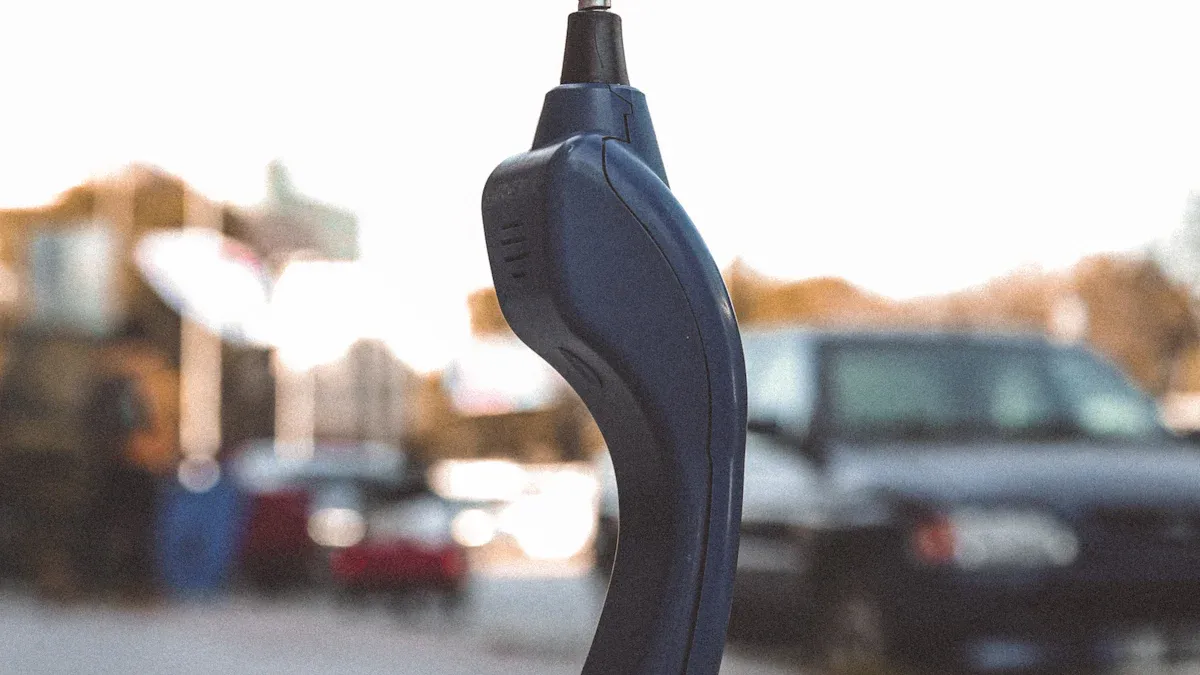
Industrial retro rugged handsets stand out in station environments for their robust performance.
- These devices pass MIL-STD-810 tests, including temperature shock, humidity, and vibration.
| Environmental Condition | Parameter Range / Value |
|---|---|
| Operating Temperature | -40 to 85°C |
| Vibration (Sine) | Up to 10g peak, 5-2000 Hz |
| Altitude | -1,500 to 60,000 ft |
The industrial telephone handset delivers consistent communication where modern devices often fail.
Key Takeaways
- Industrial retro rugged handsets offer unmatched durability and reliable communication in harsh station environments, working well under extreme temperatures, vibration, and dust.
- These handsets play a critical role in safety by providing direct, always-available lines for emergency communication, even during power outages or system failures.
- Compared to modern devices, industrial handsets are simpler to use, require less maintenance, and deliver consistent performance when it matters most.
The Legacy of Industrial Telephone Handset Design
Origins in Station Communication
Station communication began to transform in the late 19th century. Inventors like Edison introduced the carbon microphone, which improved voice clarity and reliability. Early telephones featured separate transmitters and receivers, making operation less convenient. By the early 20th century, the Bell model 102 telephone combined both functions into a single molded plastic handset. This innovation set the standard for future designs and increased efficiency in station environments.
| Time Period / Event | Description |
|---|---|
| Late 19th century (1877-1878) | Edison invents the carbon microphone, enhancing voice transmission. |
| 1890s | Candlestick telephones appear, using magneto generators and switchhooks for better operation. |
| Early 20th century | Bell model 102 introduces the integrated handset and cradle design. |
| Early 20th century | Central-office common battery systems and rotary dials automate and simplify communication. |
| 1930s onward | Telephone bases enclose bells and coils, streamlining the device and improving efficiency. |
Note: The transition from local batteries to central-office systems marked a major leap in reliability for station communications.
Evolution to Rugged and Retro Styles
Over time, the industrial telephone handset evolved to meet the demands of harsh station environments. Designers focused on durability, using robust materials to withstand temperature extremes, vibration, and dust. Retro styles emerged, blending classic aesthetics with modern engineering. Many stations still rely on these handsets because they offer unmatched performance in challenging conditions. Their simple, tactile controls allow operators to communicate quickly, even during emergencies. This blend of heritage and innovation keeps the industrial telephone handset relevant in today’s stations.
Industrial Telephone Handset in Modern Station Operations

Critical Role in Safety and Emergency Communication
Safety remains a top priority in station environments. Operators depend on reliable communication tools to respond quickly during emergencies. The industrial telephone handset provides a direct line for critical alerts and instructions. Unlike mobile devices, these handsets do not rely on battery life or wireless signals. They connect directly to station communication networks, ensuring constant availability.
Many stations install these handsets at strategic locations. Operators can access them during power outages or system failures. The clear audio quality helps staff relay information without confusion. In hazardous situations, such as fires or chemical leaks, the industrial telephone handset allows personnel to coordinate evacuation or emergency response.
Tip: Regular testing of emergency handsets ensures they function when needed most.
Real-World Use Cases from Station Environments
Industrial telephone handsets serve many functions in active stations. Staff use them to report equipment malfunctions, request maintenance, or communicate with control rooms. In subway stations, these handsets often appear on platforms and in tunnels. Train operators use them to contact dispatchers if onboard systems fail.
A typical scenario involves a power outage. The main communication system may go offline, but the industrial telephone handset continues to operate. Maintenance teams rely on these devices to coordinate repairs and restore service. In another example, security personnel use the handset to alert authorities about suspicious activity.
| Use Case | Description |
|---|---|
| Power Outage | Maintains communication when other systems fail |
| Equipment Malfunction | Allows quick reporting and response |
| Emergency Evacuation | Coordinates staff during fire or hazardous incidents |
| Security Alert | Provides direct line to law enforcement or control room |
These examples show the versatility and reliability of the industrial telephone handset in real-world station operations. Staff trust these devices to deliver clear, uninterrupted communication in any situation.
Unique Advantages Over Modern Communication Devices
Durability and Performance in Harsh Conditions
Industrial environments often expose equipment to extreme temperatures, dust, moisture, and vibration. Many modern devices struggle to function in these settings. The industrial telephone handset stands out because it uses reinforced materials and sealed components. These features protect the device from water, dust, and impact. Operators can rely on these handsets during storms, power outages, or heavy machinery operation.
A quick comparison highlights the difference:
| Feature | Industrial Telephone Handset | Modern Smartphone |
|---|---|---|
| Water Resistance | High | Moderate to Low |
| Shock Resistance | High | Low |
| Operating Temperature | Wide Range | Limited |
Note: Many stations choose these handsets for outdoor or hazardous locations because they continue to work when other devices fail.
Simplicity and Reliability Under Pressure
Complex technology can slow down response times during emergencies. The industrial telephone handset uses a straightforward design. Operators pick up the receiver and connect instantly. There are no apps, passwords, or touchscreens to navigate. This simplicity reduces the risk of mistakes when time matters most.
Staff members report fewer technical issues with these handsets. They do not require frequent updates or charging. The direct connection to station networks ensures clear communication, even if wireless signals drop.
- Easy to use in stressful situations
- Minimal maintenance required
- Consistent performance in all conditions
Tip: Simple tools often provide the most reliable support during critical incidents.
Technological Advancements in Industrial Telephone Handset
Enhanced Connectivity and Integration Capabilities
Modern station environments demand seamless communication across multiple platforms. Recent advancements have transformed connectivity and integration for industrial handsets. Devices now support cloud-based hosted phone systems, which allow users to switch calls between desk phones and mobile devices. This flexibility supports mobility for remote and hybrid workforces. Enhanced collaboration tools—such as video, chat, and call recording—are now standard, making communication more efficient.
A look at key technological milestones highlights the rapid evolution:
| Technological Advancement | Description and Impact on Connectivity |
|---|---|
| Transistor & Integrated Circuits | Miniaturized devices, enabling compact and efficient handsets. |
| Digital Switching | Converts analog voice to digital, improving efficiency. |
| Packet Switching | Sends data in packets, increasing network efficiency. |
| Wireless Communications | Enables mobility and frequency reuse. |
| Fiber Optics | Delivers high-speed data transmission. |
| Cellular Technology (1G–5G) | Boosts speed, capacity, and integration. |
eSIM technology further streamlines connectivity. It allows remote provisioning and management of SIM profiles, eliminating physical SIM swaps. This feature supports real-time updates and seamless network switching, which are critical for uninterrupted operations in industrial settings.
Security and Compatibility with Modern Systems
Security remains a top concern for station operators. Modern handsets use encryption, authentication, and Transport Layer Security (TLS) to protect sensitive data. Secure provisioning ensures only authorized devices access the network. These features help prevent unauthorized access and data breaches.
Compatibility with modern systems is another strength. Devices integrate with cloud platforms, supporting automatic updates and scalability across multiple locations. Superior audio quality—achieved through echo cancellation and background noise suppression—ensures reliable communication. Hearing aid compatibility and multilingual interfaces make these handsets accessible to a diverse workforce.
Tip: Regularly updating firmware and security protocols helps maintain system integrity and protects against emerging threats.
Comparing Industrial Telephone Handset to Contemporary Tools
Strengths and Limitations in Station Settings
Industrial stations demand communication devices that perform reliably under stress. Traditional handsets offer several strengths in these environments. Their rugged construction resists damage from drops, moisture, and dust. Operators appreciate the tactile feedback of physical buttons, which allows quick dialing even with gloves. These devices connect directly to wired networks, so they do not depend on cellular coverage or battery life.
However, some limitations exist. Fixed installation restricts mobility. Users cannot carry these handsets throughout the station. The lack of advanced features, such as messaging or video calls, may limit their usefulness for certain tasks. Maintenance teams sometimes need to replace worn cords or clean contacts to ensure optimal performance.
Tip: Evaluate the specific needs of each station area before choosing between traditional and modern devices.
Scenarios Where Modern Devices Fall Short
Modern smartphones and tablets offer convenience and versatility. Yet, they often struggle in harsh station environments. Extreme temperatures can drain batteries quickly or cause devices to shut down. Dust and water may damage sensitive electronics. Wireless signals sometimes fail in underground tunnels or remote locations.
In emergencies, touchscreens may become unresponsive if users wear gloves or if the screen gets wet. Complex interfaces can slow response times when every second counts. Many operators report that traditional handsets provide more reliable communication during power outages or network failures.
- Modern devices excel in flexibility but may lack the durability and simplicity required for mission-critical station operations.
User Perspectives and Industry Feedback
Insights from Station Operators and Technicians
Station operators and technicians often share positive feedback about rugged handsets. Many describe these devices as dependable tools that support daily operations. Operators value the clear audio quality, especially in noisy environments. Technicians appreciate the straightforward wiring and robust construction. They report that the handsets rarely fail, even after years of heavy use.
Operators often mention that the tactile buttons help them communicate quickly during emergencies.
Technicians highlight the ease of troubleshooting and the minimal need for specialized training.
A survey of station staff revealed the following key points:
- 92% trust the handset for emergency communication.
- 87% find the device easy to operate, even with gloves.
- 80% prefer the physical handset over touchscreen alternatives.
Maintenance, Longevity, and Cost Considerations
Maintenance teams report that these handsets require little upkeep. Most issues involve cleaning or replacing cords, which takes only a few minutes. The rugged design reduces the risk of damage from drops or exposure to dust and moisture. Many stations use the same units for over a decade, which lowers replacement costs.
| Factor | Impact on Operations |
|---|---|
| Low Maintenance | Reduces downtime |
| Long Lifespan | Lowers total cost of ownership |
| Simple Repairs | Minimizes technical support needs |
Stations often choose these devices for their reliability and cost-effectiveness. The industrial telephone handset remains a practical investment for environments that demand durability and consistent performance.
Industrial retro rugged handsets continue to serve as vital tools in station environments. Their classic design and modern features make them more than nostalgic items. The industrial telephone handset delivers unmatched reliability. Ongoing advancements will help these devices remain relevant as communication needs evolve.
FAQ
What makes industrial retro rugged handsets suitable for harsh environments?
Engineers design these handsets with reinforced materials and sealed components. The devices resist water, dust, and impact, ensuring reliable operation in extreme conditions.
How often do industrial telephone handsets require maintenance?
Maintenance teams usually inspect these handsets annually. Most repairs involve cleaning or replacing cords. The robust construction minimizes the need for frequent servicing.
Are industrial telephone handsets compatible with modern communication systems?
- Most current models support integration with digital and VoIP networks.
- Manufacturers provide adapters and firmware updates to ensure compatibility with evolving station infrastructure.

